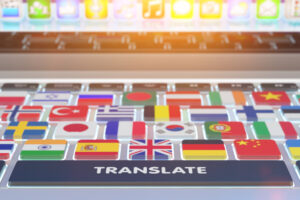Note: This blog post was originally written in Japanese for our Japanese website. We used our machine translation platform Translation Designer to translate it and post-edit the content in English. The original Japanese post can be found here.
As more businesses go global, the demand of multilingual translation is rising.
In Japan, major languages we see in multilingual translation projects are Chinese, Korean, Thai, and Spanish. But sometimes, requests can include other languages, such as Macedonian, Czech, and Vietnamese, and can be very diverse.
In our previous posts, we have shared about Spanish translation and Chinese translation. This time, we're taking you on a translation journey of Arabic, including some helpful tips when translating the language.
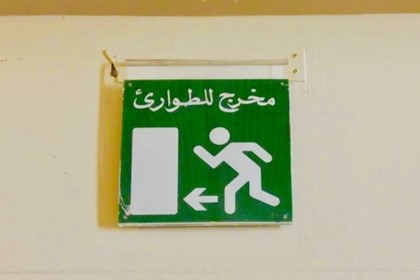
Let's learn about Arabic
What comes in your mind when you hear "Arabic"? You might imagine a desert sunset like the world of Arabian Nights or a mosque that shines in the setting sun. Or you might just think of an earthworm-like writing that reads from right to left.
Most of those images are correct. Arabic is written in Arabic alphabet as you see below, and you read it in a direction from right to left.
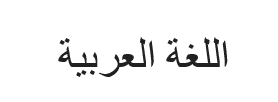
It is a language mainly spoken in the Middle East region centered on the Arabian Peninsula, which was the setting for the Arabian Nights. Many people in Japan probably think of Arabic as a minor language because they don't see Arabic frequently in Japan. Also, it is rarely offered as a class in schools and universities.
However, as most of us know, Arabic is actually the third most used language in countries and regions around the world. It has 350 million* native speakers. (*Source: Wikipedia)
This number of speakers is said to be the fifth largest after Chinese, English, Hindi, and Spanish. In addition, Arabic is the official language of the United Nations alongside English, French, Chinese, Russian, and Spanish.
Although Arabic is not a familiar language in Japan, it obviously has a very high speaker population on a global scale. As a result, the demand for Arabic translation continues to grow.
Which countries and regions speak Arabic?
So, where is it specifically that speaks Arabic?
Countries and regions that use Arabic as their official language range from the Middle East regions, such as Saudi Arabia, UAE, Qatar, Iraq, Palestine, Jordan and Yemen, to North Africa, such as Egypt, Tunisia, Algeria, Morocco, and Sudan. By the way, Iran uses Persian, which shares a very similar alphabet as Arabic alphabet.
Just as Japanese is spoken in different dialects from north to south, Arabic also has a unique dialect in each region. In some cases, even the same Arabic speaker may hardly understand the language due to the difference in dialect.
For example, the dialect spoken in Morocco has become far different from that of other countries and regions. One of the reasons is the Berber language, which was spoken in this region before Arabic. Also, the French language strongly influenced the dialect due to Morocco's history as a French colony.
All of these dialects, i.e., spoken language, which differ from region to region are varieties of Arabic.
Colloquial Arabic and literary Arabic
So, as long as there are different dialects, Arabic speakers can't communicate with each other?
No, that's not the case. Other than these dialects, which are colloquial Arabic, there is also a literary language (also known as modern standard Arabic), and it serves as the common language of Arab countries. Modern standard Arabic is called Fusha and is used in public settings such as newspapers, books, academic papers, and news articles.
Fusha is also the language in which the Islamic Koran, a classical Arabic literature, was written. Moreover, Fusha is the Arabic language taught at school, so general Arabic speakers learn and understand Fusha. However, since Fusha is a language used only in public settings, it is rarely heard in daily conversations.
As for documents, when translating into Arabic, many will be probably translated into Fusha. Even so, there are some exceptions. In cases where you need translation for marketing or literary content, the translation might use dialects such as the Egyptian dialect.
When requesting Arabic translation services, the important thing to remember is to have a solid idea of the situation and regions where the deliverables will be used.
The horizontal direction of Arabic
Now that we have talked about the things to look out for when translating into Arabic, we would like to add one more thing to take into consideration for Arabic translation or localization, which is unique to this language.
We briefly explained earlier that you read Arabic in the direction from right to left. This is very important. If your original document is written in English or Japanese, you will be reading the translation in the opposite direction. This means you have to be aware that the layout of the translated document will be reversed.
Let's look at an example. Here is the English global website of Emirates Airline based in Dubai, UAE.
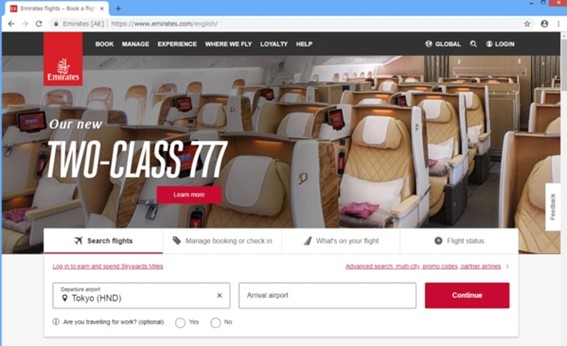
Next, this is how the page looks like when you select the UAE version website in Arabic.

You can easily see that the layout is bilaterally symmetric.
It's worth keeping in mind that Arabic translations can make significant layout changes depending on the language in which they were originally written.
We already know Arabic words?
By the way, although Arabic does not seem like a familiar language in Japan, it is actually hidden in the words we use in our daily lives.
For example, words such as alcohol, alkali, and algorithm are said to have originated from Arabic. This is because "al" in Arabic is a definite article (e.g., "the" in English). By knowing this, maybe it's easier to see more words that originated from Arabic.
In fact, there are many such words in the scientific field. From the Middle Ages to the modern era, the Middle East developed greatly in terms of science. This can be seen in the House of Wisdom of Abbasid dynasty that once existed in Baghdad, the capital of Iraq. The Middle East's development had a great influence on Western countries.
For this reason, there are many words of Arabic origin that are frequently used in our daily lives. It may be a fun project to search for more words of Arabic origin if you are an avid language learner.
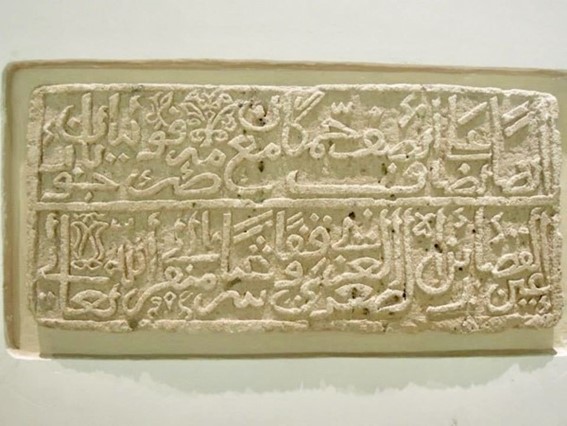
The beauty of Arabic calligraphy
There is even more. One of the features of Arabic is Arabic calligraphy.
As mentioned earlier, Arabic is the language in which the Islamic sacred book Koran was written, and Muslims consider Arabic to be the word of Allah. Since Islam prohibits idolatry, this helped evolve the decorative writing methods for beautifully writing the Koran's words. If you go to a mosque, you can see the beautiful Arabic script that colors everywhere inside the mosque.
This is how Arabic calligraphy evolved. In Arabic-speaking countries you will see beautifully decorated Arabic writing, even if it's not a Koran quote. For example, Emirates Airline, which now flies many passengers from Asia to Europe, adopts a logo that is an Arabic calligraphy of "Emirates."

Qatar-based broadcaster Al Jazeera has a logo of "Al Jazeera" in the form of flames in Arabic calligraphy.

The decorative writing that make words an art can be said to be unique to Arabic.
Summary
We hope this post gave you a little more understanding of Arabic translation. Since Arabic has a different reading direction and many dialects, it is true that the translation and localization work is difficult. However, it is a language that is expected to further grow in terms of translation demand in the future.
Most people will probably not link Arabic or Arabic alphabet to Japan, but if you look around, you'll be surprised at how you'll find them in Japan as well. By reading this post, we hope that Arabic translation becomes more familiar to you.
Kawamura's translation services
For translation and localization work that requires selecting subtle nuances of words and arranging designs according to the local region, a support by professional translation services is vital.
Feel free to reach out to us!
Kawamura has been providing professional translation services since 1986 and is happy to support your localization needs.
_CMYK_OL.png)
